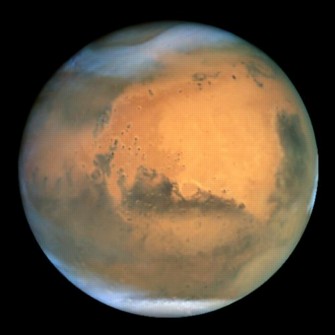






Martian Flotilla
by Robert Gounley
2004 is going to be a big year for Mars. Four spacecraft from three different space programs are on their way to explore the planet. Two are already there.
It’s enough to make even long-standing Mars buffs a little giddy – and a bit anxious.
 |
| Hubble photograph of Mars, June 26, 2001. Image Credit: NASA and the Hubble Heritage Team (STScI/AURA)Acknowledgment: J. Bell (Cornell U.), P. James (U. Toledo), M. Wolff (Space Science Institute), A. Lubenow (STScI), J. Neubert (MIT/Cornell) |
Mars fascinates us. New pictures from its surface are assured worldwide attention, just like Mars Pathfinder received in 1997 and the Viking Landers a generation earlier. Views from orbiting spacecraft generate widespread discussion of their interpretation – be it the cliff-face gullies or sightings of Elvis. No other planet registers in the human imagination as place where one day we could leave a footprint. It may once have had life of its own; some scientists think it still does.
Scientific curiosity prompts robotic exploration, but many space activists see them as precursors for astronauts with geologist’s hammers. They hope that practice with robots now leads to humans soon after.
Practice has not always gone well. 1999 saw the failure of three Faster-Better-Cheaper missions (Mars Climate Orbiter, Mars Polar Lander, and Deep Space 2). Ten years ago, ground controllers lost contact with the Mars Observer spacecraft. In spite of notable space accomplishments elsewhere, Soviet/Russian space programs have had little success on Mars after 11 attempts. The planet demands a lot from its visitors.
The upcoming flotilla of Mars spacecraft may well color perceptions for future manned missions there. If many fail, should we send people? If most succeed and robotic exploration produces satisfying results, should we send people? Advocates see value in human exploration under either scenario – people respond creatively to emergencies and can quickly distinguish a valuable sample from just another rock. Critics see great risks and costs in the billions of dollars. Overcoming their concerns requires compelling evidence both that Mars is sufficiently interesting and that the risks are clearly understood.
Robotic missions can provide those things. 2004 will be the 35th anniversary of mankind’s first landing on the Moon. Will robotic discoveries draw us towards higher goals?
For more information on current Mars missions on the Web:
Copyright © 1998-2005 Organization for the Advancement of Space Industrialization and Settlement. All Rights Reserved.